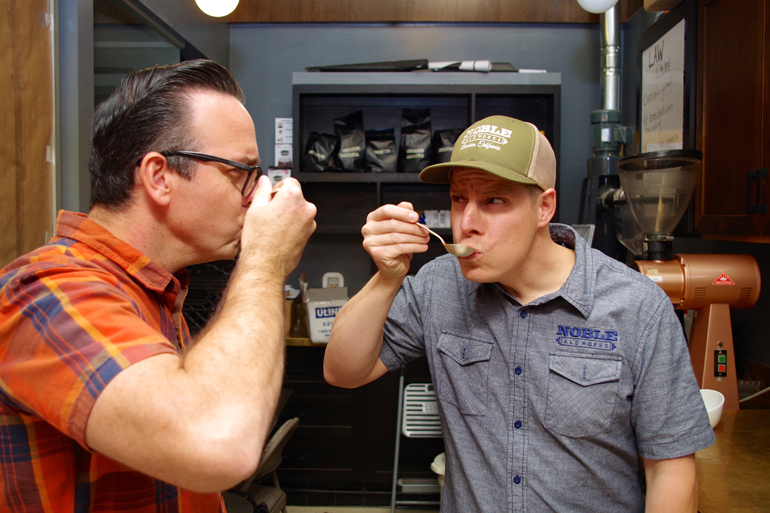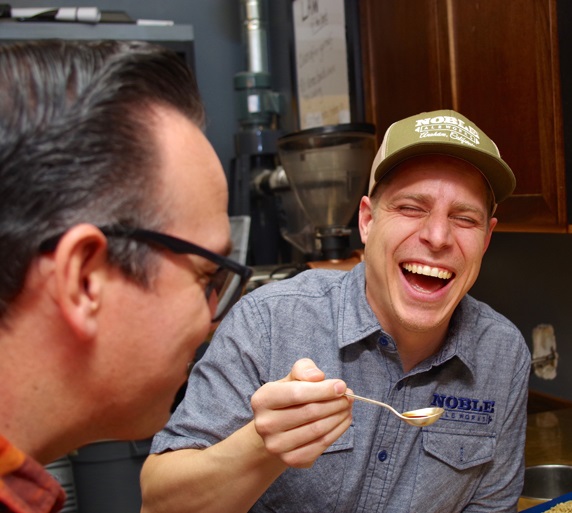Start 14-Day Trial Subscription
*No credit card required

The Rise of Coffee Beers
Honing in on the grind
Once the origin characteristics are decided on for a beer, the real decisions are made at the cupping table. This is where cold-brew coffee is produced to blend into live beer. At the cupping table, generally three to six bean choices are laid out for evaluation. Pre-grind and post-grind notes are taken, then 200-degree water is added and left to settle for exactly 13 minutes.
With a deepwelled, nonreactive metal spoon, the brulee-looking coffee froth is broken while one inhales deeply with the nose a pinkie finger’s length away from the hot liquid. Raking the spoon back and forth, intense aromas explode into your olfactory receptors, or don’t, depending on the bean. Finally, coffee is slurped loudly off of the spoon with the idea of coating the entire tongue. Flavor, taste, and mouthfeel are evaluated, scores are taken, and a decision is made.

Once the origin characteristics are decided on for a beer, the real decisions are made at the cupping table.
When cupping, the ratio of 8.25 grams of whole bean coffee to 5.07 fluid ounces of water are precisely measured out. The idea is to be exact as possible, leveling the playing field for each cup.
Sean Flannery, brewer at The Bruery and founder of nano-roaster Coldbot Coffee, mentions that the cupping table can be misleading. “Cupping uses 200-degree water to extract the flavor compounds and oils from the coffee. In the beer process, the coffee is cold-steeped anywhere from 34 to 68 degrees Fahrenheit.”
Other coffee beer brewers agree that there are differences in what the cupping table achieves, but it helps evaluate overall quality and how it may fit into the beer’s desired characteristics. “For my coffee beers, I want the coffee to be in symphony with the other flavors and not overly dominant,” says Julian Shrago, brewer of Beachwood BBQ & Brewing’s award-winning Mocha Machine Imperial Porter.
Adding chilled shots of espresso or cold-brew coffee into a pint is yet another method one can use to evaluate, but it may also not necessarily translate to the finished product.
Dosage Best Practice
After the origin, blend and roast are done, it’s time to brew some coffee beer. Post-fermentation, the burr grinder is cleaned and fine mesh bags are filled. For coffeeforward beers, a ratio of one pound of coffee per 10 gallons of beer is used. For the lighter side, one pound per 20 gallons is used. Since coffee extraction is a time-per-temperature equation, on average three days contact time yields the best results. There’s no danger of overextraction. After 24 hours, the beer is pulled off and sampled; if it’s perfect, it’s sent off for packaging.

Noble Ale Works head brewer Evan Price has a chuckle after sipping a fresh coffee beer.
Enjoy by?
Furthering the hoppy beer parallels, coffee beer is best enjoyed fresh. When purchasing, it’s best to check the date. Just as a bottle of cold-brewed coffee has a shelf life, time slowly chips away at the volatile aroma compounds found in coffee beers. It’s best to store coffee beer in colder temperatures, and cellaring is highly frowned upon.
If you’ve got the “12-bar blues," seek out The Brews Brothers, coffee and beer, for a harmonious taste performance guaranteed to get your foot tapping.
Photos courtesy of Greg Nagel.
Pages
- « first
- ‹ previous
- 1
- 2
- 3



